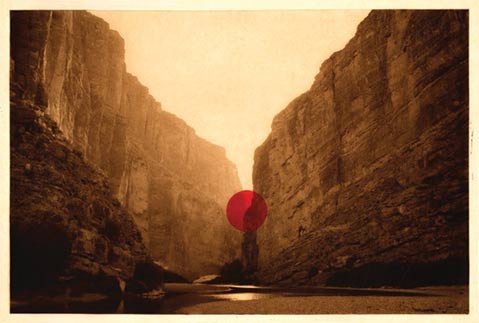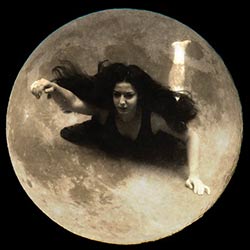Review: Parmet and Blackwood: Unbound at wall space gallery
New Work by Top Artists on View through December 28

From its beginnings, one of the great promises of photography has been unparalleled immediacy — the sense that the image puts the viewer in a specific place to witness a particular moment in time. In this new double show at wall space, the ghost of that initial promise, now distorted beyond recognition by technology and time, returns in work that trades the illusion of photographic transparency for a different connection to the here and now.
For Christa Blackwood, whose work refracts the romantic landscape tradition of such masters as Edward Weston and Ansel Adams through a feminist lens, the beauty of nature inspires an imaginative offset in the form of a transparent red dot. By placing these markers within her elegant photogravure prints of deserted western landscapes, Blackwood inserts a sign that substitutes for the nude female figure, that ubiquitous symbol of natural beauty employed by so many of her predecessors as a means of humanizing empty spaces.
Like the “you are here” markers on functional wall maps, these dots invite the viewer to reimagine the subject of the image as it relates to his or her own experience of the current moment. Although that imaginative act of placing a woman’s body in the landscape is already loaded with potential complications, when Blackwood’s red dots start showing up in stunning portraits of shirtless young men, the equation becomes exponentially more fraught. By combining such coolly deliberate strategies of estrangement with evident technical facility in archival developing and printing processes, Blackwood embodies the aesthetic mission of many of the artists who show at wall space, which is to restore the shock of the new to photography, a medium in which even the most controversial gestures rapidly devolve into clichés.

Blackwood’s images complement the recent work of Barbara Parmet, another contemporary artist who is equally astute in her critical response to the status of photography in the world today. Parmet’s latest work requires extensive preparation, as the subjects are all posed underwater in order to achieve a variety of anti-gravitational effects, but the typical signifiers one associates with underwater photography are conspicuous by their absence. Parmet prints these dreamy images of women floating in various dramatic postures on pieces of wood, and she leaves the wood grain intact as a separate layer of texture to complicate the surface. It’s a daring technique that could easily lead to murky results, but in Parmet’s sure hands, the effects are dazzling. Whether it’s the languid backstroke of the young woman in “After the Wave,” the flying leap of the figure in “Suspension,” or the magnificent beatitude of the swimming pool Madonna in “untitled,” each of these images delivers a powerfully complete sensation of cinematic narrative. Such alchemy in mixed media remains rare. Parmet’s Zen discipline of letting go and simplifying allows her extraordinary compositions to react with, rather than fight against, the luminous qualities of the wood. Although she began her career as a photojournalist, in this phase, Parmet may not have traveled as far afield as it may seem on first glance. These sensual, mysterious images report on her inner state, and through them we get a glimpse of where she is right now, both in and out of the game, watching and wondering at it



